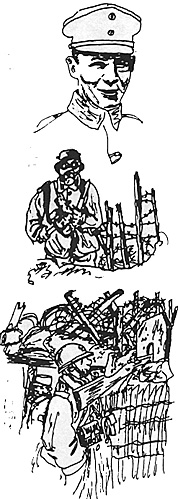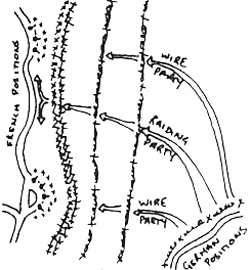
Trench raids were part of the daily diet of trench life during quiet periods between the 'great pushes' of 1915-18. It was a harrowing, brutal and very deadly type of warfare completely in keeping with the almost medieval siege conditions that the soldiers were experiencing.
The aim of the raid was many: to keep the enemy on edge and hopefully wear him down, to boost the morale of your own troops, to 'blood' new battalions, to capture or destroy a trench mortar that may have been causing annoyance, to tap the enemies telephone wire, destroy the entrance of a located mineshaft, to map his defences for a coming push, or, as in this scenario, to collect prisoners for intelligence purposes. Whatever the objective of these 'minor trench operations', between December 1915 and June 1916 some 6,845 men were killed and 119,296 wounded on the British sector of the Western Front alone.
Many of the early trench raids were organised more like night raids on public school dormitories than serious operations of war, but with experience came professionalism. Some HQ's began to keep league tables of units successes and failures, presenting silver cups to the most daring units or prizes such as rest periods near big towns or home leave to 'blighty'. Many officers and even a few other ranks were able to make a name for themselves winning distinction and promotion, though for most this was short-lived.
Nor were all trench raids small affairs. Though most were carried out by sections or platoons, frequently whole companies and often whole battalions were Involved. So there is great scope for a solo campaign, which can be picked up and carried on as the whim or time suits. I have created a fictional battalion 7th Royal Stokeshires', whose companies are competing against each other with blackened faces, mills bombs and dubs. 'B' Company is gaining a good lead at the present time, having just come off best from an encounter with a German patrol out in No Man's Land.
The "Pinetree Knob" Raid
In early October 1916, the 2nd Company Wurtemburg Mountain Battalion received orders to raid the French positions in front of them in order to secure prisoner/s for interrogation. The company commander was Lieutenant Erwin Rommel.
Immediately, Rommel accompanied by two sergeants reconnoitered the French trenches from No Man's Land. After a few days planning, Rommel concluded that raiding the position known as 'Pinefree Knob' would provide the best chance of success. More days and nights of careful observation and reconnaissance followed to locate the exact positions of the French outposts and fathom the routine of the guards. Only 500 feet separated the German from the French trenches, across a grass covered field, defended by three separate belts of barbed wire. One concealed sentry post was located in the centre of the Plnetree Knob position, whilst the other lay two hundred feet to the north on a rocky ledge from which it was easy to cover the surrounding terrain by machinegun fire.
 Rommel's plan called for the raiding party of twenty men to cut their way through the wire between the two French positions to cut down the possibility of detection. Two more wire cutting parties would start work cutting their way through the wire opposite the enemy outposts to facilitate the escape of the assault party. The night chosen was overcast and raining heavily reducing visibility and the alertness of the rain sodden sentries. A high wind drowned out the notes of the wire cutting. It was 21.00 hrs when the raiders left their trenches.
Rommel's plan called for the raiding party of twenty men to cut their way through the wire between the two French positions to cut down the possibility of detection. Two more wire cutting parties would start work cutting their way through the wire opposite the enemy outposts to facilitate the escape of the assault party. The night chosen was overcast and raining heavily reducing visibility and the alertness of the rain sodden sentries. A high wind drowned out the notes of the wire cutting. It was 21.00 hrs when the raiders left their trenches.
Four soldiers with wire cutters preceded the assault party, cutting through the first two entanglements easily enough. The third was a high and continuous chevaux-de-false. Attacking this with the cutters made lots of noise and it looked like the raid would fail. A brief recon found a shellhole under which the raiders could wriggle. As the first men wormed their way through even as a French patrol passed by, failing to notice the intruders.
Once through the wire, Rommel led Staff Sgt Schropp and 10 men north to the ledge outpost, whilst Lieutenant Schafferdt went south with a further 10 men towards the sentry post. Rommel's party had almost come upon their objective when a grenade exploded taking out the first man in the party. In the confusion a shower of grenades fell among them. Rommel roared 'Let's Go!' and ran under the next grenade salvo and in hand-to-hand combat overpowered the four Frenchmen.
Finding a near-by dug-out Rommel personally took the seven French occupants prisoner. Satisfied, he withdrew before French reinforcements came, and back at the assembly point on their own side of the wire found that Schafferdt's party had collected two prisoners without any casualties. A good night's work well done.
Scenario
For my games, and when I can get away with it, I use a low wattage bulb inked blue to illuminate my gaming table, as suggested by Donald Featherstone in Battles With Model Soldiers. For trench raiding rules I use a semi-role-play set derived from Skirmish Wargames, again by Don Featherstone and RECON from RPG Inc.
At first I had a trench system built from papier mache, but it was difficult to store (and I admit didn't look that great), but recently I've invested in resin commercially available trench positions, which give greater versatility (it can be different each time). Remember, you only need to represent the enemy's trenches, his wire and a section of No Man's Land.
Wire in 25mm can be made from the stringy bags that oranges / grapefruit come in.
The scenario starts with the Germans inside the French wire and about to enter the trench. Unless part of a campaign, gaming the initial movements and wire cutting is pretty fruitless and usually bloody. You can either play both assault groups or just Rommel's party.
The German raiding party would have clubs, pistols (officers and NCOs), sharpened entrenching tools and plenty of grenades. A later war stormtrooper unit might have Bergmann sub-machineguns and even body armour too. The wire parties would give covering fire from No Man's Land to aid the withdrawal if necessary.
Now, take a pack of playing cards and separate the picture cards (J/Q/K/Joker). Shuffle your hand of picture cards and place two on each position.
Turn over one card from the main deck at the end of each Move. If Raiders 'HALT' to check sounds etc. remove four cards from the bottom of the deck per move and discard, however one picture card must also shuffled in per Move of 'HALT.'
Raiders Movement is:
- Cautious: Move 4" &shuffle one picture card into the deck.
Wary: Move 6" & shuffle two picture cards Into the deck.
Hurried: Move 8" & shuffle four picture cards Into the deck
If the card turned over is a red picture card (J/Q/K), there is an encounter with enemy troops, roll 1xD6 for numbers. It the raiders were 'Halted' or the previous card drawn was a black card, the raiders have the upper-hand and get one free shot or hack at the unsuspecting foe, who must then check their morale.
If the previous card was red, both sides are alert and fighting simultaneously. Any shooting or explosions cause all remaining picture cards to be shuffled into the main deck. From now on turn three cords per Move.
Should the picture card turned be block, then our heroes have come across a dug-out. Turn another cord, if a picture card then the dug-out holds 1 x D10 troops. (Red = alert shoot at raider entering while Black = surprised, check morale).
A Joker represents a shower of grenades throw 1x AvD-1 : Turn a card per raider Red J/Q/K = Dead / Black J/Q/K = Wounded, Number card = No Effect. Now turn another card if not red J/K/Q then bombers have run away.
The Objective:
Before entering the objective position, turn over one of the two cards previously put to one side. Joker = grenade shower as above / Red card = 1 x AvD troops, If small arms or grenades have been used so far then garrison is ready, otherwise only if previous Movement card was a red one / Black = dug-outs no troops in the trench but check dug-outs as above.
Before leaving the objective, turn second card. Joker = grenade shower followed by counter-attack by 2x AvD enemy. Red = Surprise counter-attack by tx AvD enemy. Black = No Effect.
There we have it, a short and simple system which I hope gives the feel of the uncertainty of trench raiding. There's no need to use it in the Great War setting, it could be in the trenches around Vloksburg, Sebastopol, Namur, Jerusalem etc.
Back to The Gauntlet No. 3 Table of Contents
Back to The Gauntlet List of Issues
Back to Master Magazine List
© Copyright 1995 by Craig Martelle Publications
This article appears in MagWeb.com (Magazine Web) on the Internet World Wide Web.
Other articles from military history and related magazines are available at http://www.magweb.com